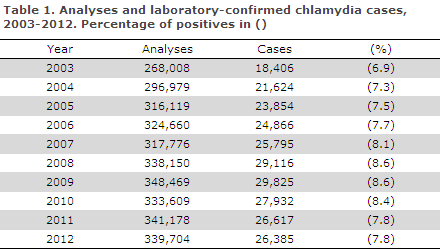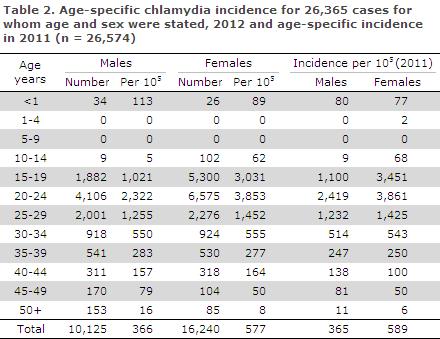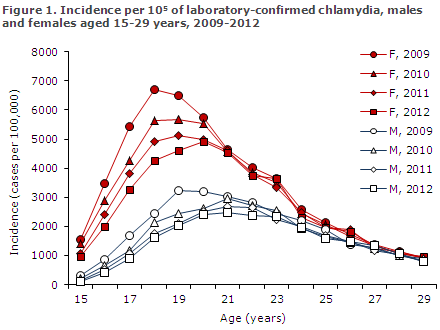No 36 - 2013
Chlamydia 2012
Chlamydia 2012
The laboratory notification system for chlamydia (oculogenital infection caused by Chlamydia trachomatis) receives quarterly data on laboratory-confirmed chlamydia from clinical microbiology departments and from one clinical biochemical department.
2012 saw the detection of 26,385 chlamydia cases (26,617 in 2011). This corresponds to an annual incidence of 473 per 105 (479 per 105 in 2011 and 505 per 105 in 2010). A total of 339,704 analyses were performed, and the number of detected cases comprised 7.8% hereof, Table 1. This share rose in the 2003-2009 period from 6.9% to 8.6% and then dropped to 7.8% in 2011 and 2012.

A total of 79% of males and 87% of females were aged 15-29 years (80% and 88%, respectively, in 2011), Table 2. Compared with 2011, the sex- and age-specific incidences for both sexes decreased in the age groups 10-14 years, 15-19 years and 20-24 years, while they increased in the age groups 25-29 years, 30-34 years and 35-39 years, and particularly so among the 40-44-year-olds. The incidence remained unchanged for men overall, but decreased for women (from 589 to 577).

As in 2011, the highest incidence among men was found among 21-year-olds, Figure 1. Among women, the highest incidence was found in 20-year-olds, as opposed to 2011 when the highest incidence was observed among 19-year-olds. For both sexes, the incidences were lower in 2012 than in 2011 for all 1-year age groups from 15 to 22 years, and for about half of the 1-year age groups from 23 to 29 years.
As in the 2009-2011-period, males constituted 38% of the diagnosed cases. This proportion has previously followed a steady, increasing trend from 23% in 1994.

Geographical distribution
Based on the municipal code of the practice or hospital department where the specimen was obtained, each individual chlamydia case may be ascribed to a specific municipality, part of country or region, Table 3.

Compared with 2011, the general pattern was that of an increase in the incidence in the City of Copenhagen, on Funen and in West Jutland, and for males also in North Zealand and East Jutland. For both sexes, a decrease was observed in the majority of the remaining areas. The M/F ratio remained largely unchanged.
Diagnostics
A total of 92% of the positive specimens were submitted by general practitioners and 7% by hospitals. All cases were detected using DNA amplification methods. Chlamydia was detected in urine samples in 8,834 cases, i.e. in 36% of all cases (33% in 2011). Samples from men constituted 87% of the positive urine samples (90% in 2011).
Urine was used as sample material in 82% of the chlamydia cases from men (79% in 2011). All laboratories reported positive findings in urine specimens. Rectal chlamydia was detected in 123 men (131 in 2011).
Chlamydia in children
Chlamydia was found in 179 children less than 15 years of age (183 in 2011 and 257 in 2010). Among these children, 62 (35%) were younger than one year of whom 58 had conjunctivitis, one had a positive throat swab, and in three cases the test site was not stated.
Among 19 children under the age of one year with conjunctivitis, for whom the age was stated in months, 13 were aged less than one month and two were three months old. Urogenital chlamydia was detected in ten 13-year-old and 90 14-year-old girls and in nine 14-year-old boys.
The incidence among 10-14-year-old girls was 62 per 105 in 2012 (68 in 2011, 99 in 2010 and 127 in 2009), while the corresponding figure for boys was 5 per 105 (9 in 2011, 14 in 2010 and 11 in 2009).
Commentary
The number of detected cases decreased slightly in 2012 compared with 2011. The number of chlamydia analyses and the share of positives remained largely unchanged compared with 2011. Compared with previous years, the age distribution seems to be changing towards fewer cases and a lower incidence among the younger age groups, while a slight increase is observed among the older age groups.
As in 2009-2011, the proportion of men among the detected cases had levelled off at 38%, but there is no reason to believe that chlamydia is less prevalent among men than among women. Increased testing of men should therefore be continued. The number of men who had rectal chlamydia detected remained practically unchanged. When rectal chlamydia is found in a man, he should also be tested for syphilis, gonorrhoea, lymphogranuloma venereum (LGV) and HIV, EPI-NEWS 20/2008.
(S. Hoffmann, Microbiology and Infection Control)
Link to previous issues of EPI-NEWS
4 September 2013